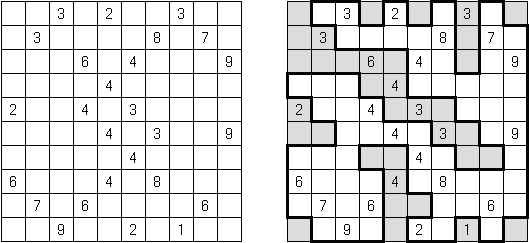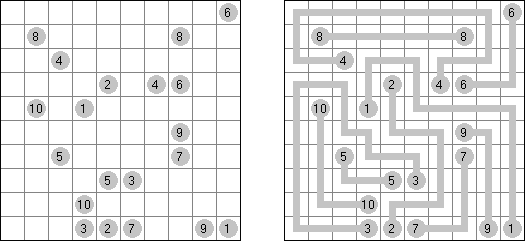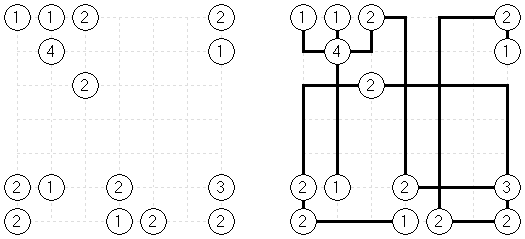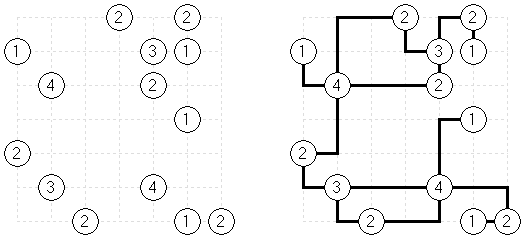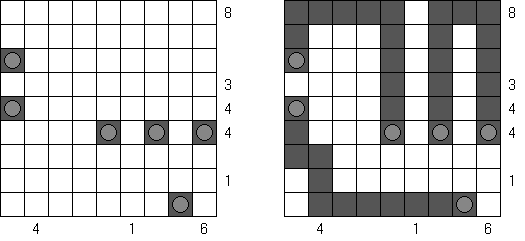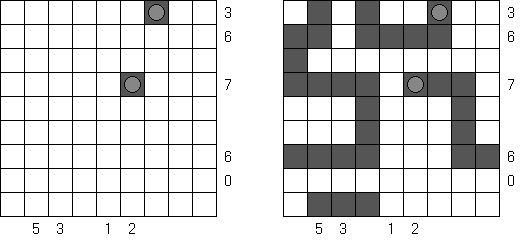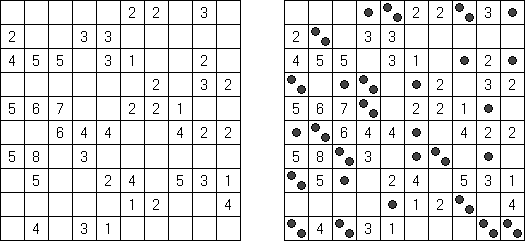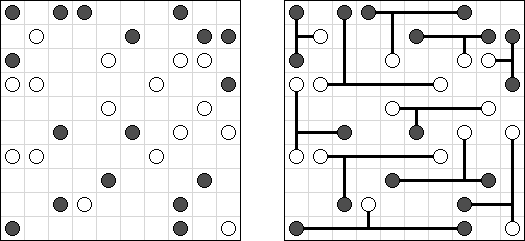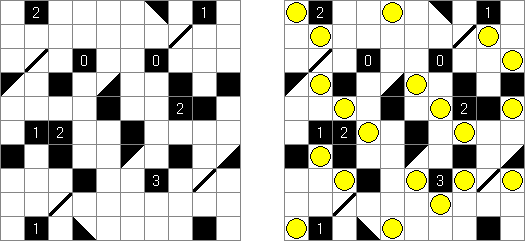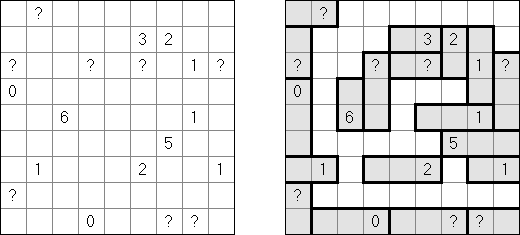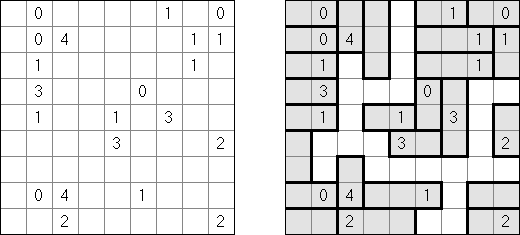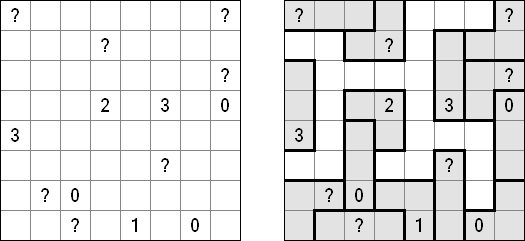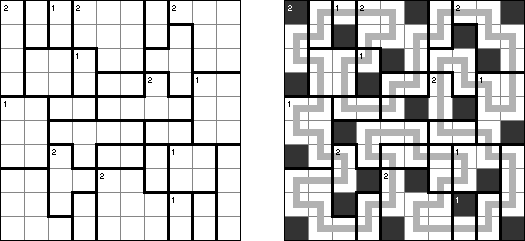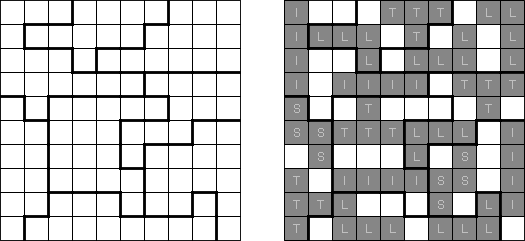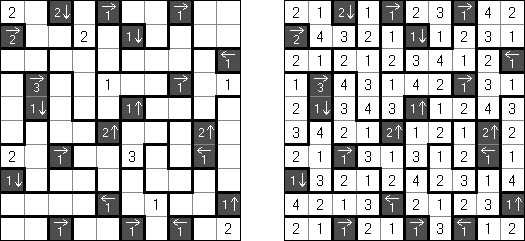|
|
Cross+A  Logiikkapelien esimerkkejä Logiikkapelien esimerkkejäJoissakin palapeleissä on klassisten sääntöjen lisäksi muunnelmia. Cross+A voi ratkaista ja luoda näitä palapelimuunnelmia (joko samassa ikkunassa kuin klassinen versio tai erillisessä ikkunassa uutena palapelityyppinä).
Slitherlink Lampaat ja sudet ("Sheep and Wolves") on Slitherlink-logiikkapelin laji: numerojen 0-3 lisäksi tehtävässä on myös mustia ympyröitä (lampaat) ja ristejä (sudet). Tehtävän ratkaistua "lampaiden" tulee olla säätöpiirissä (tarhassa) entä susien tarhan ulkopuolella.
Battleships In Digital Battleships all cells of the grid contain numbers. The values on the right and bottom edges of the grid reveal the sum of the numbers in each of the ship pieces that appear in each respective row or column.
Retrograde Battleships ("Reverse Battleships") contains all segments of the ships in the grid. The aim is to find the correct locations of the ships. No ship may touch another, even diagonally.
Fillomino No Rectangles Fillomino sisältää yhden lisäsäännön: ei mikään yksikkö voi olla suorakulmion tai neliön muotoinen.
Only Rectangles Fillomino: kaikkien yksikköjen tulee olla suorakulmion tai neliön muotoisia.
No 2 x 2 Squares Fillomino: ruudukkoon ei saa sisältyä yhtäkään 2x2-ruudukkoa, jossa on samoja numeroja.
Non-Consecutive Fillomino: kahden vaara- tai pystysuorassa toisiinsa koskevan yksikön ruudut eivät saa erota toisistaan ykkösellä.
Consecutive Fillomino: jokaisen yksikön tulee koskea vaaka- tai pystysuorassa vähintään yhteen muuhun yksikköön, jonka koko eroaa sen koosta vähintään yhdellä ruudulla.
No Row/Column Repeats Fillomino ("Deadomino"): samaan riviin tai sarakkeeseen sisältyvät kaikkien samojen numerojen tulee sisältyä samaan yksikköön. Esimerkiksi, jos rivissä on kaksi viitosta, niin ne molemmat sisältyvät samaan yksikköön.
All Odds Fillomino: kaikkien yksikköjen koot ovat parittomia.
All Evens Fillomino: kaikkien yksikköjen koot ovat parillisia.
Nurikabe Line Nurikabe: a grid cannot contain five consecutive black cells in a row or column (2 x 2 cell area can be all black).
Pairs Nurikabe eroaa tavallisesta Nurikabe-pelista sillä tavalla, että jokaiseen "saareen" sisältyy kaksi lukua, joiden summa on sama kuin "saaren" pinta-ala.
Skyscrapers Sum Skyscrapers eroaa tavallisesta Skyscrapers-pelista sillä tavalla, että, marginaaleissa olevat luvut eivät kerro näkyvissä olevien talojen lukumäärästä, vaan niiden talojen kaikkien kerrosten summasta.
Tapa Olemassa on monta Tapa-pelin muunnosta. Cross+A pystyy ratkaisemaan jotkin niistä. Tapa-pelin [Line]-versiossa käytössä on lisäohje: mustien ruutujen muodostama vaaka- tai pystysuoran rivi voi olla enintään kolme ruutua pitkä.
No Squares Tapa: ruudukossa ei saa olla yhtäkään 2 x 2 ruutua, joka koostuu vain valkoisista ruuduista.
Equal Tapa: valkoisten ruutujen lukumäärä on sama kuin mustien ruutujen (paitsi lukuruutuja).
B&W Tapa:
Tapa Islands:
Pata:
Tapa Balance: ruudukon vasemmalla puolella olevien mustien ruutujen lukumäärä on sama kuin ruudukon oikealla puolella. Valkoisia ruutuja eikä lukuruutuja ei huomioida.
Tapa Row: rivin kaikkien lukujen summa on sama kuin saman rivin kaikkien mustien ruutujen lukumäärä.
Tapa 1-n: kaikissa riveissä ja sarakkeissa olevat mustien ruutujen lukumäärät ovat erilaisia.
Dissected Tapa: mustat ja valkoiset ruudut muodostavat kaksi yhteensopivaa kuviota. Kahta kuviota pidetään yhteensopivina kun ne ovat samoja toistensa päälle pantaessa.
Tapa [Diagonal Neighbors]: jokaisen mustan ruudun vieressä tulee olla vähintään yksi musta ruutu, johon se koskee vinottain.
Corral Inside/Outside Corral on Corral-logiikkapelin laji. Numerot voivat sisältyä suljetun linja sekä sisä-, että ulkopuolelle. Molemmissa tapauksissa numero tarkoittaa "näkyvien" ruutujen määrää oma ruutu mukaan luettuna.
Arukone Arukone3:
Easy as ABC Not as Easy as ABC is a variation of Easy as ABC puzzle. The goal is to fill in the first letters of the alphabet on every row and every column exactly once. One cell in every row and every column remains empty. Letters and numbers on the outside indicate at what position you come across this letter when looking from that side (e.g. C2 means the C is the second letter encountered when looking from that side).
Ichimaga Crossing Ichimaga: the lines may cross other lines; the lines cannot change direction at the point of intersection.
Magnetic Ichimaga ("Jishaku-Ichimaga"): the circles with the same digits cannot be connected.
Snake Multiple Snakes: a grid contains multiple snakes. Head and tail of all snakes are given. Different snakes do not touch each other, even diagonally.
Toroidal Snake: a grid wraps around itself. A snake can go from one edge to another.
Minesweeper Double Minesweeper: place mines into each empty cell in the grid, at most two mines per cell.
Mirukuti Milk Tease is a variation of Mirukuti ("Milk-T") puzzle. T-shaped line may connect:
Two circles of the same color must be connected by the straight-line segment of the T-shaped line.
Light Up Mirror Akari ("!irakAkari!"): a square or rectangular grid contains diagonal walls (black triangles) with mirrors.
Tren Tren+:
Ghost Tren:
Mubunanba Mubunanba+:
Yajilin Regional Yajilin (also known as "Yajilin (Regions)") is a square or rectangular grid divided into regions. The aim is to blacken some cells and to draw a single non-intersecting loop through all the white cells. A number in a region indicates the number of black cells in that region. A region without a number can contain any amount of black cells. No two black cells can share a border. The loop may visit numbered cells; numbered cells can be blackened.
LITS Double LITS has one difference from the classic variant of the puzzle: each region must contain two tetrominoes. These two tetrominoes within a region cannot touch each other horizontally or vertically (only diagonally); they can be the same or different shapes.
Kapama Sunglasses is a logic puzzle. A rectangular or square grid contains lines ("bridges") in some cells. The goal is to blacken some cells to create pairs of figures (twin shapes). Twin shapes ("lenses") are symmetrical with respect to a bridge. Two lenses may not share an edge. Cells with bridges can not be blacken. Numbers outside the grid show the number of black cells in a corresponding row or column.
Makaro Masakuchi is a logic puzzle published by Nikoli. A rectangular or square grid is divided into regions. Each region must be filled with each of the digits from 1 to the number of cells in the region. When two numbers are orthogonally adjacent across a region boundary, the numbers must be different. The grid may contain black cells with arrows and numbers: the arrow points at the greatest number among the four cells around (up, under, left, right) the black cell. The number in the black cell shows the difference between the greatest number and the second highest number in all orthogonally adjacent cells around the black cell.
|
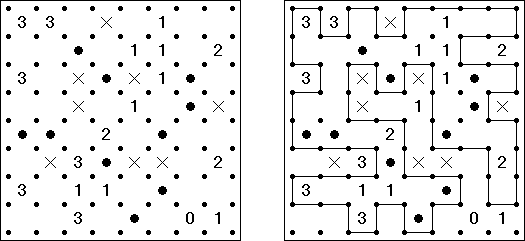
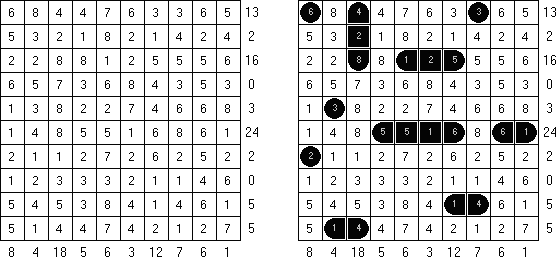

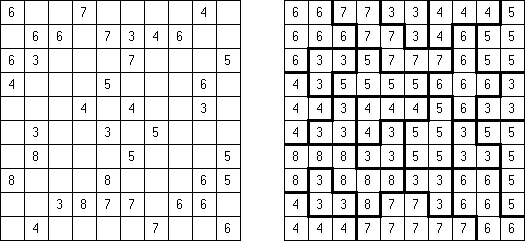

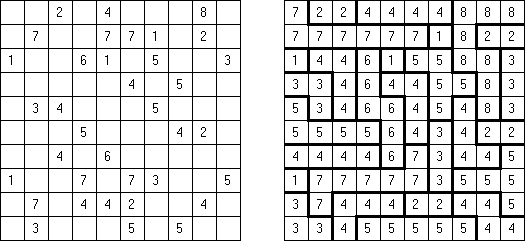
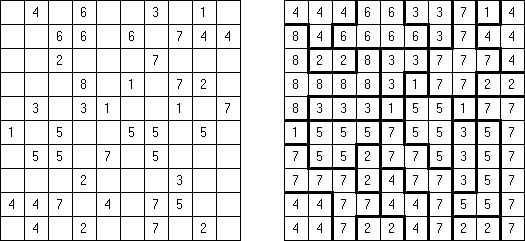
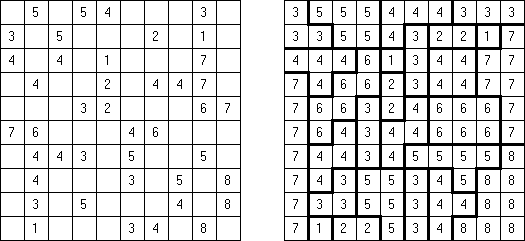
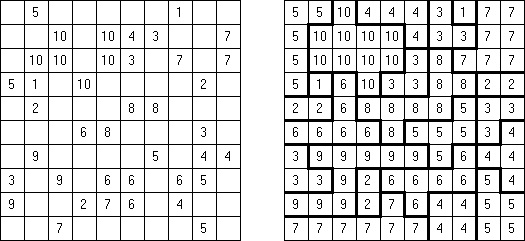



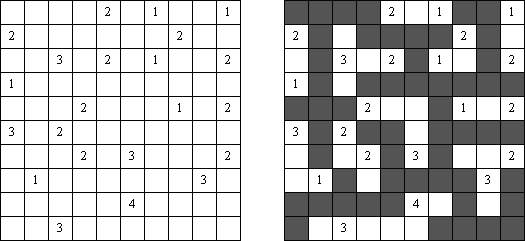
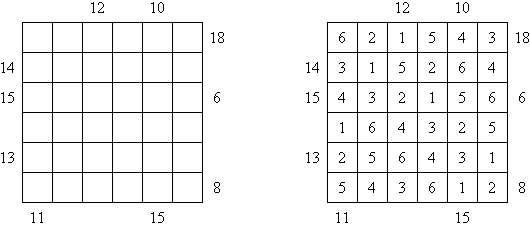
![Tapa [Line]](../data/tapa1.gif)
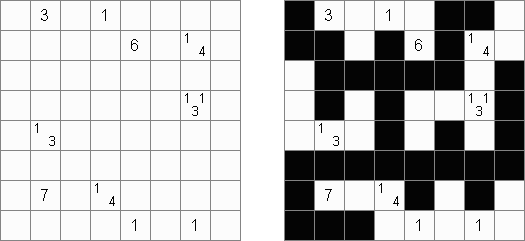
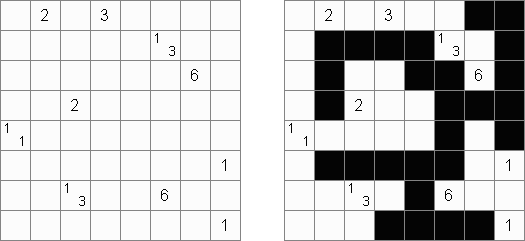


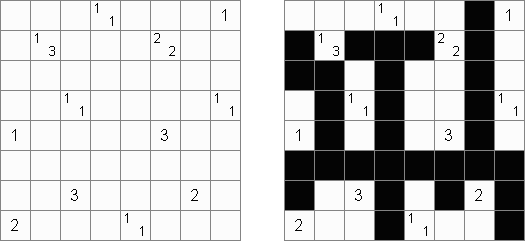
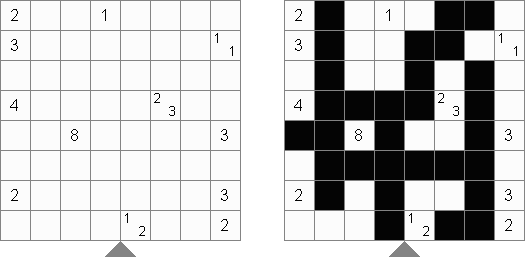
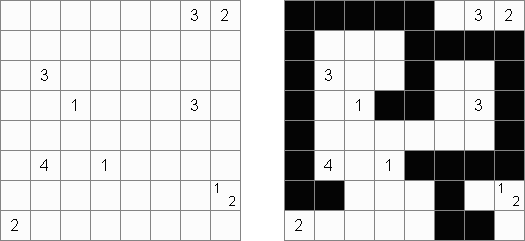

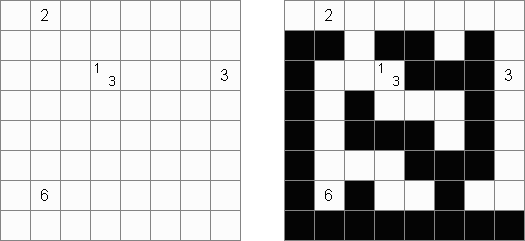
![Tapa [Diagonal Neighbors]](../data/tapa11.gif)
